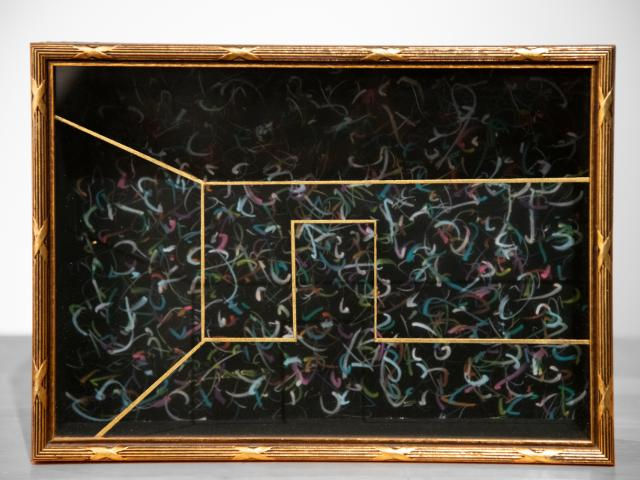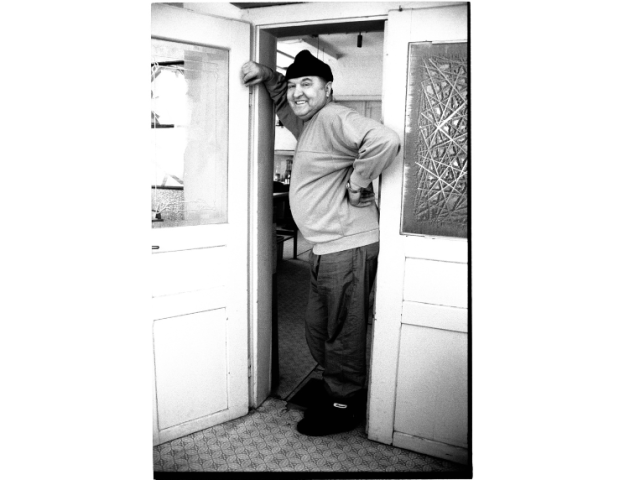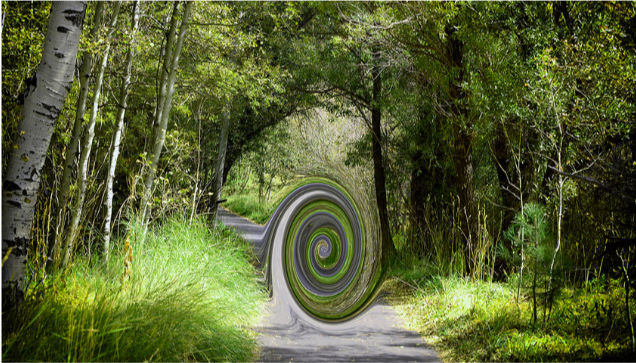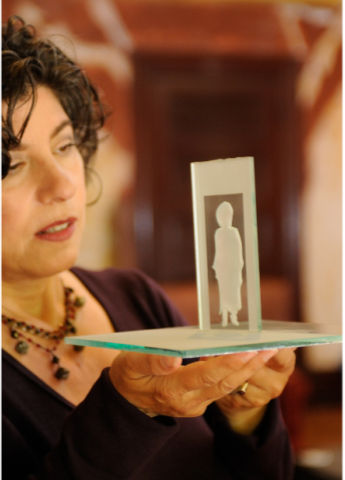The Threshold Between Worlds and a Life of Creative Vision. UCSB, College of Creative Studies, BA Sculpture, Janna Waldinger ‘79
- jannawaldinger
- Aug 7
- 11 min read

"As an artist, I walk between worlds—material and spiritual, visible and invisible. My life and work are both a constant navigation across that threshold.”
“Nearly 50 years later, the stories and lessons from CCS still resonate and inspire me to share. I live to help others reframe their perspective. Whether through a photograph, a sculpture, or an ‘InSightful Session,’ I invite people to stand on the threshold—to see with new eyes.”
—Janna Waldinger ‘79 (CCS Art)
At the College of Creative Studies (CCS), we relish the opportunity to showcase members of our community. We recently connected with Janna Waldinger ‘79 (CCS Art) who reflected on her life and art work. In this story, Janna also gives us a glimpse of her journey through the College of Creative Studies (CCS). What stood out to us about Janna could not be better expressed than her own words:
“When I live a life that is original, it brings me a deep sense of fulfillment and joy. Seeing life through the eye of the artist brings new creative life force into my being. I find meaning in paths, portals, windows, and doorways. They are the metaphors of my life.”
This is Janna’s story.
College of Creative Studies: An Incubator for the Intuitive Builder

For Janna, her journey through the College of Creative Studies (CCS) from 1976 to 1979 was not just an education—it was an “alchemical transformation” as she put it. As a fiber artist, sculptor, photographer, and conceptual thinker, CCS was not merely a launchpad for her but a crucible—where her lifelong fascination with symbolism, materiality, psychology, and spirituality fused into an expressive, visionary practice.
Born in 1958 in Los Angeles, Janna grew up in a household where creativity and contribution were core values. A third-generation photographer, she began apprenticing with her father at age seven—assisting on shoots, working in the darkroom, and learning to read light and shadow as fluently as language. Her upbringing was enriched by music, spirituality, and activism. Even in her teens, Janna was designing her own independent study programs and immersing herself in the fiber arts movement of the 1970s.
By the time she graduated high school, Janna had traveled the world, become politically active, and started her path as a spiritual seeker. “Inspired by the writings of Hermann Hesse, Alfred Korzybski, and Jane Roberts,” Janna expressed, “I was committed to making the invisible visible.”
When it came time for college, Janna’s sister—then a UCSB student—recognized that the unique environment of CCS was the perfect place for her to thrive.
At the College, Janna found a model of learning that echoed her independent spirit. The program’s contract-based assignments, close mentorships, and small community of fellow creatives gave her the freedom and guidance she needed to flourish.
Her early influences converged at the College. Then, sculpture professor Michael Cochran introduced Janna to tools and techniques that grounded her conceptual explorations. Inspired by Elizabeth Haich’s Initiation, Janna became fascinated with the cube as a symbol of the material world and the tetrahedron as a representation of spiritual reality.
“I took on the challenge of creating sculptures of psychological states, using the cube—the symbol of the tangible world—and the tetrahedron revealed inside it: the spirit, the unseen,” Janna recalls fondly. Instructor John McCracken inspired Janna’s use of small strokes of color, described as “a signature of the moment” in her paintings and sculptures. These brushstrokes served as a bridge between the energetic worlds—or vibrational reality—and the more tangible, visually apparent world we’re all so familiar with.

Janna was inspired also by David Trowbridge’s work: “where he blended the man-made world with monochromatic canvases with organic unpainted natural slabs of tree sections pairing the natural shapes found in nature with man-made constructions of square painted or gold leaf surfaces.” For Janna, “I translated my interest in these concepts within monochromatic weavings.”
She experimented with minimalism and abstraction, moving from earthy-toned weavings to translucent Plexiglas sculptures. Janna’s pieces included framed weavings made from white toilet paper—fragile and ephemeral—challenging traditional ideas of value and permanence. In addition, she drew inspiration from artists such as Judy Chicago, Agnes Martin, and Larry Bell, translating their philosophical aesthetics into three-dimensional constructions.
Janna’s education at CCS was equally experiential. Weekly field trips with David Trowbridge to artist studios in Venice and downtown Los Angeles exposed her to the living environments of practicing artists. “We visited three artists a day, seeing firsthand how art and life intertwined,” she recollects.
Returning to her memories at CCS, Janna said: “I continue to this day to retell stories shared in Tom Wudl’s class, “Boredom, Depression in the Studio, Fun in the Kitchen.” A three-hour class that started with a slide show of historical paintings tracing the psychological consciousness of man through time, how God and spiritualism was represented in paintings, a cooking class comparing cooking to art making and an education in anatomy. She continued, “Tom would emphasize how we have highly flatulent ideas of how the world should be and yet we don’t even know how our own bodies work.”
“I strongly believe this experience, Independent study in Barcelona with master weaver Josep Grau Garriga, expanded my reach and cemented my identity as an international artist.” —Janna Waldinger ‘79 (CCS Art)
In 1978, she studied abroad conducting an independent study in Barcelona with master weaver Josep Grau Garriga. Janna apprenticed in his studio, set up her own loom in a rented apartment, and exhibited in the Foga 2 Galeria de Arte. “I strongly believe this experience expanded my reach and cemented my identity as an international artist,” Janna recalls with pride.
Art Beyond the Academy: Washington, D.C., New York, and Social Practice
After completing her studies at CCS in three and a half years, Janna held a solo exhibition in the CCS Gallery, then dove headfirst into professional practice. While mentioning that, she reflected: “I don’t know why I was in such a hurry to graduate.” She exhibited caged American flag sculptures in Washington, D.C. during the Iran hostage crisis, and also showed her work in Santa Barbara and Vermont.

In 1980, Janna moved to the east coast, building art studios in her homes in Hoboken, New Jersey; Grand View-On-Hudson, New York; and later in a TRIBECA loft in New York City. She created sculptures, paintings, performance art, videos, weavings, photography, and curated exhibitions at the New York Feminist Art Institute. She photographed the work of other artists, including Louise Bourgeois, and joined Wendy Clarke’s Disarmament Project, video-taping public opinion interviews and shared video clips gathered from across the world, in Grand Central Station.
Janna was quoted in the August 19, 1985 Time Magazine article “This Could Be Ground Zero” for her social action of painting silhouette shadows on the streets of New York City on the 40th anniversary of the Hiroshima bombing. She launched her line of “Janna Original Art Plates”—functional art pieces featured in The New York Times and Gourmet Magazine, and sold at Henri Bendel, Gracie Mansion Museum Shop, and museum shops from coast to coast.
West Coast Return and Deepening the Path
“In San Francisco, I embraced new materials—gold leaf, sandblasting glass, and utilized projected light—within the city’s thriving glass art scene.”
—Janna Waldinger ‘79 (CCS Art)

Throughout the 1980s, per Janna, “I refined my visual language while studying jazz flute, piano, astrology, and Jungian psychology—further deepening my symbolic vocabulary.” In 1986, she returned to California when her husband, Paul Josephson, began graduate school at University of California, San Francisco (UCSF). Just before leaving New York, she said, “I was invited by famed window designer Gene Moore to display my sculptural work in Tiffany & Co.’s windows on Fifth Avenue. Then in San Francisco, I embraced new materials—gold leaf, sandblasting glass, and utilized projected light—within the city’s thriving glass art scene.” Janna’s installations became increasingly immersive—glowing cubes, chicken wire tetrahedrons, and silhouetted figures on plexiglass casting ethereal shadows on the walls.
“I’m an out-of-the-box artist.”
—Janna Waldinger ‘79 (CCS Art), article in Napa Valley Life, January 20, 2020


While in San Francisco, she pursued an M.A. in Arts & Consciousness at JFK University [located in Orinda, CA; closed in 2020], a program integrating psychology, spirituality, and the creative process. She found a vibrant creative home at the Hatley Martin Gallery in San Francisco—an incubator for boundary-pushing, socially engaged art—where she served as director and championed emerging and experimental artists committed to cultural dialogue and innovation. Janna co-directed the Hatley Martin Cultural Forum, a non-profit wing of the gallery which later became the Institute for Living Arts (IFLA), and contributed to Vox Art Magazine. In 1991, she co-led “The Art of Ecology, Recycling The Collective Spirit” in Prague and exhibited various artworks including creating Stůl Nedůvěry (“Table of Distrust”), a sculptural installation made of concrete, broken glass, and sandblasted dinnerware inscribed with the names of toxic chemicals—an urgent environmental warning in the wake of the Velvet Revolution [a non-violent transition of power in what was then Czechoslovakia occurring on November 17 - 28, 1989].
Photography and Education in Napa: Art & Clarity
“My life and work reflect the very ethos of CCS: forging one’s path with courage, curiosity, and care.”
—Janna Waldinger ‘79 (CCS Art)
In San Francisco in 1991, Janna launched Art & Clarity—a photography studio dedicated to portraiture, education, and visual storytelling. She and her creative partner of 36 years, Lowell Downey, relocated to Napa Valley in 1994. “There,” Janna remembers “we expanded our client-centered practice with two signature photography workshops: The Art of Seeing, a three-hour session designed to help participants reframe their perspectives through the lens of the creative artist and learn to use light with poetic insight; and Make Art of My Day, a full-day immersive experience combining photography, mindfulness, and curated Napa dining—culminating in a custom art book.”

In 1997, while pregnant with their son Forest, Janna was elected to the Napa County Board of Education where she continues to serve today as its president. She played a pivotal role during the COVID-19 pandemic as student services manager for If Given A Chance, mentoring trauma-impacted students through their last year of high school and their undergraduate college years.
A New Lens: Digital Evolution and Artistic Renewal
“I grew up in the darkroom, dodging and burning prints under the red glow of the safe-light. Now I use digital tools with the same reverence for light, composition, color, and contrast.”
—Janna Waldinger ‘79 (CCS Art)

Janna’s recent creative work focuses on altered photography—digitally transforming landscapes and paths into swirling portals of layered perception. “These works build on my lifelong interest in transition, archetypes, and spiritual geometry, Janna said. “I grew up in the darkroom, dodging and burning prints under the red glow of the safe-light. Now I use digital tools with the same reverence for light, composition, color, and contrast.” In 2024, she studied with master photographer Serge Ramelli in France, accelerating her digital expertise. And, more recently, Janna smiled and mused: “I am excited about my newly launched online store that showcases collaborative works with Downey that reflect decades of creative exploration.”
Legacy and Vision

Janna’s story is a testament to the power of art as a tool for transformation, connection, and inner vision. “Nearly 50 years later, the stories and lessons from CCS still resonate and inspire me to share. I live to help others reframe their perspective. Whether through a photograph, a sculpture, or an ‘InSightful Session,’ I invite people to stand on the threshold—to see with new eyes.”
Janna’s advice for CCS students:
Stay curious.
Question authority.
Find your authentic voice.
Explore classes across CCS and UCSB.
Be kind.
Find those who can say yes.
Celebrating Influences of CCS Classes and Teachers
To celebrate the influences CCS classes and instructors had in Janna’s life, she provided written memories. CCS thanks Janna for her testimonial of CCS classes and the dedication of CCS faculty to students, a College community-centric learning culture that remains til today. Janna, with gratitude from all of us at the College. You are an inspiration for current and future students as well as members of the CCS community.
“Michael Cochran was my sculpture mentor. With my dedication to other worldly, esoteric study, I was deeply influenced by Elizabeth Haich’s 1040’s book Initiation. She was a woman during WWII who retreated to her country cabin in Germany and wrote about her past life memories of her training as a priest in ancient Egypt. I was struck by the reference of how the cube represented the 3D world and how when bisecting all six sides it forms a tetrahedron or hidden form inside the 3D world or spirit inside the tangible world. Feminism was raging and so were the fiber arts. I contributed to Judy Chicago’s Dinner Party Project. Yet, choosing to learn how to construct Plexiglas translucent cubes—cubes within cubes and revealing tetrahedrons within became a passion for 40 years and is still found in my sculpture, representing an archetype of making the invisible visible and making tangible concepts of the world we cannot hold on to. Having a workshop, tools, table saws, and studio space to create was essential to experimenting and exploring various artistic modalities. Michael Cochran taught me the use of these tools.
John McCracken was the link to using art as a bridge between the energetic worlds or sub particles, vibrational reality and our more familiar tangible visual apparent world as we are all so familiar with.
David Trowbridge had a magnificent way of blending the man-made world with monochromatic canvases with organic unpainted natural slabs of tree sections pairing the natural shapes found in nature with man made constructions of square painted or gold leaf surfaces. I translated my interest in these concepts within my fiber art into monochromatic weavings—including a series of white toilet paper of rhythmically textured weaving that were framed in Lucite boxes to protect the fragile surfaces.
Previously my weaving incorporated earth ones of brown, beige, green and rust colors in a flowing abstract pattern. I shifted to a single neutral palate. Later creating construction of stretched fabric rectangles with woven sections also stretched taking on a Mondrian style to a 3-dimensional blend of geometrical shapes and textures. I discovered Anges Martin and was influenced by her minimalist pink monochromatic paintings with thin pencil lines horizontally drawn across the surface. Her writings referred to the importance of being dissatisfied with one’s work that motivates and propels the artist into further explorations rather than settling into complacency.
I continue to this day to retell stories shared in Tom Wudl’s class, “Boredom, Depression in the Studio, Fun in the Kitchen.” A three-hour class that started with a slide show of historical paintings tracing the psychological consciousness of man through time, how God and spiritualism was represented in paintings as divine nature and landscapes. People later began to be depicted only as tiny elements in nature within magnificent landscapes. During the Renaissance 14th century, wealthy European men commissioned portraits of themselves and their family. European artists in the mid- 15th century began to insert themselves as characters within their works. With advancing studies of psychology, with Freud and Jung, as we were peering into the human mind, artists like Picasso were deconstructing reality. Tom would emphasize we have “highly flatulent ideas of how the world should be and yet we don’t even know how our own bodies work. He included images of our inner anatomy; one example was comparing a young girl's ovary with an older woman’s ovaries. Did you know that the ovaries do not have an opening to release a human egg cell? The egg must explode piercing the wall of the ovary to enter the uterus each month. So, the image of a young girl’s ovary looks more like a testicle sack and the older woman’s ovary having years of eggs burst through it, looks more like the surface of the moon with craters left through the surface. I had no idea, and I can still see those slides distinctly in my mind even 50 years later which sparks my desire to know more about our inner workings. The second half of the class time was dedicated to hands-on cooking. In making and sharing one’s art, the artist has to be responsible like a cook—what one is serving. The focus and craft of art making requires respect of the materials and skill in presentation, to take serious consideration of what you are creating.
I lived and studied in Barcelona for a quarter in 1978. I worked with a master weaver Josep Grau Garriaga as an independent study class that I requested credit for. I set up a loom in an apartment I rented and worked daily in Grau’s studio as an apprentice weaving his tapestries under his direction. Also, I was part of an exhibition of his students at the Foga 2 Galeria de Arte, Barcelona, Spain. I don’t know why I was in such a hurry to graduate. I completed my course requirements in three and a half years and graduated in December of 1979.”
—Janna Waldinger ‘79 (CCS BA Sculpture)
Originally published on UCSB College of Creative Studies Website - July 29, 2025 Republished here with permission.

Comments